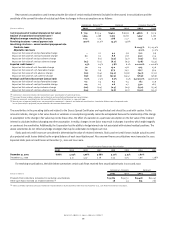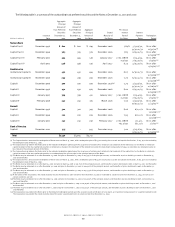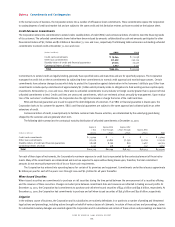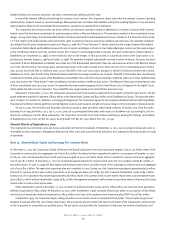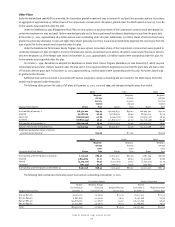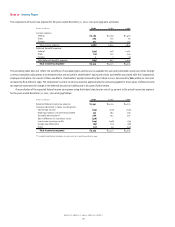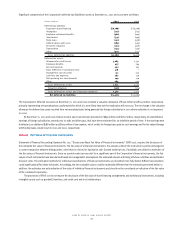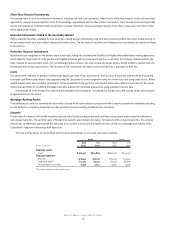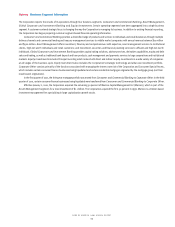Bank of America 2001 Annual Report Download - page 108
Download and view the complete annual report
Please find page 108 of the 2001 Bank of America annual report below. You can navigate through the pages in the report by either clicking on the pages listed below, or by using the keyword search tool below to find specific information within the annual report.
BANK OF AMERICA 2001 ANNUAL REPORT
106
Note 14 Regulatory Requirements and Restrictions
The Federal Reserve Board requires the Corporation’s banking subsidiaries to maintain reserve balances based on a percentage of certain deposits.
Average daily reserve balances required by the Federal Reserve Board were $4.0 billion and $4.1 billion for 2001 and 2000, respectively. Currency and
coin residing in branches and cash vaults (vault cash) are used to partially satisfy the reserve requirement. The average daily reserve balances, in excess
of vault cash, held with the Federal Reserve Bank amounted to $128 million and $3 million for 2001 and 2000, respectively.
The primary source of funds for cash distributions by the Corporation to its shareholders is dividends received from its banking subsidiaries. The
subsidiary national banks can initiate aggregate dividend payments in 2002, without prior regulatory approval, of $4.0 billion plus an additional amount
equal to their net profits for 2002, as defined by statute, up to the date of any such dividend declaration. The amount of dividends that each subsidiary
bank may declare in a calendar year without approval by the Office of the Comptroller of the Currency (OCC) is the subsidiary bank’s net profits for
that year combined with its net retained profits, as defined, for the preceding two years.
The Federal Reserve Board, the OCC, the Federal Deposit Insurance Corporation and the Office of Thrift Supervision (collectively, the Agencies)
have issued regulatory capital guidelines for U.S. banking organizations. Failure to meet the capital requirements can initiate certain mandatory and
discretionary actions by regulators that could have a material effect on the Corporation’s financial statements. At December 31, 2001 and 2000, the
Corporation and Bank of America, N.A. were classified as well-capitalized under this regulatory framework. There have been no conditions or events
since December 31, 2001 that management believes have changed either the Corporation’s or Bank of America, N.A.’s capital classifications.
The regulatory capital guidelines measure capital in relation to the credit and market risks of both on- and off-balance sheet items using various
risk weights. Under the regulatory capital guidelines, Total Capital consists of three tiers of capital. Tier 1 Capital includes common shareholders’
equity and qualifying preferred stock, less goodwill and other adjustments. Tier 2 Capital consists of preferred stock not qualifying as Tier 1 Capital,
mandatory convertible debt, limited amounts of subordinated debt, other qualifying term debt and the allowance for credit losses up to 1.25 percent
of risk-weighted assets. Tier 3 capital includes subordinated debt that is unsecured, fully paid, has an original maturity of at least two years, is not
redeemable before maturity without prior approval by the Federal Reserve Board and includes a lock-in clause precluding payment of either interest
or principal if the payment would cause the issuing bank’s risk-based capital ratio to fall or remain below the required minimum. At December 31, 2001
and 2000, the Corporation had no subordinated debt that qualified as Tier 3 capital.
To meet minimum, adequately capitalized regulatory requirements, an institution must maintain a Tier 1 Capital ratio of four percent and a Total
Capital ratio of eight percent. A well-capitalized institution must maintain a Tier 1 Capital ratio of six percent and a Total Capital ratio of ten percent.
The risk-based capital rules have been further supplemented by a leverage ratio, defined as Tier 1 capital divided by average total assets, after certain
adjustments. The leverage ratio guidelines establish a minimum of 100 to 200 basis points above three percent. Banking organizations must maintain
a leverage capital ratio of at least five percent to be classified as well-capitalized.
The valuation allowance for available-for-sale securities and marketable equity securities included in shareholders’ equity at December 31, 2001
and 2000 and the net gains on derivatives included in shareholders’ equity at December 31, 2001 are excluded from the calculations of Tier 1 Capital,
Total Capital and leverage ratios.
On September 12, 1996, the Agencies amended their regulatory capital guidelines to incorporate a measure for market risk. In accordance with
the amended guidelines, the Corporation and any of its banking subsidiaries with significant trading activity, as defined in the amendment, must
incorporate a measure for market risk in their regulatory capital calculations effective for reporting periods after January 1, 1998. The revised guidelines
have not had a material impact on the Corporation or its subsidiaries’ regulatory capital ratios or their well-capitalized status.
The following table presents the actual capital ratios and amounts and minimum required capital amounts for the Corporation and Bank of America,
N.A. at December 31, 2001 and 2000:
2001 2000
■■■■■■■■■■■■■■■■■■■■■■
Actual Minimum Actual Minimum
■■■■■■■■■■■■■■■■■■■■■■■■■■■■■■■■■■■■■■■■■■■■■
(Dollars in millions)
Ratio Amount Required
(1)
Ratio Amount Required
(1)
Tier 1 Capital
Bank of America Corporation 8.30% $ 41,972 $20,243 7.50% $40,667 $ 21,687
Bank of America, N. A. 9.25 42,161 18,225 7.72 39,178 20,308
Total Capital
Bank of America Corporation 12.67 64,118 40,487 11.04 59,826 43,374
Bank of America, N. A. 12.55 57,192 36,450 10.81 54,871 40,616
Leverage
Bank of America Corporation 6.56 41,972 25,604 6.12 40,667 26,587
Bank of America, N. A. 7.59 42,161 22,233 6.59 39,178 23,771
(1) Dollar amount required to meet the Agencies’ guidelines for adequately capitalized institutions.


